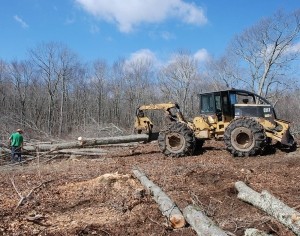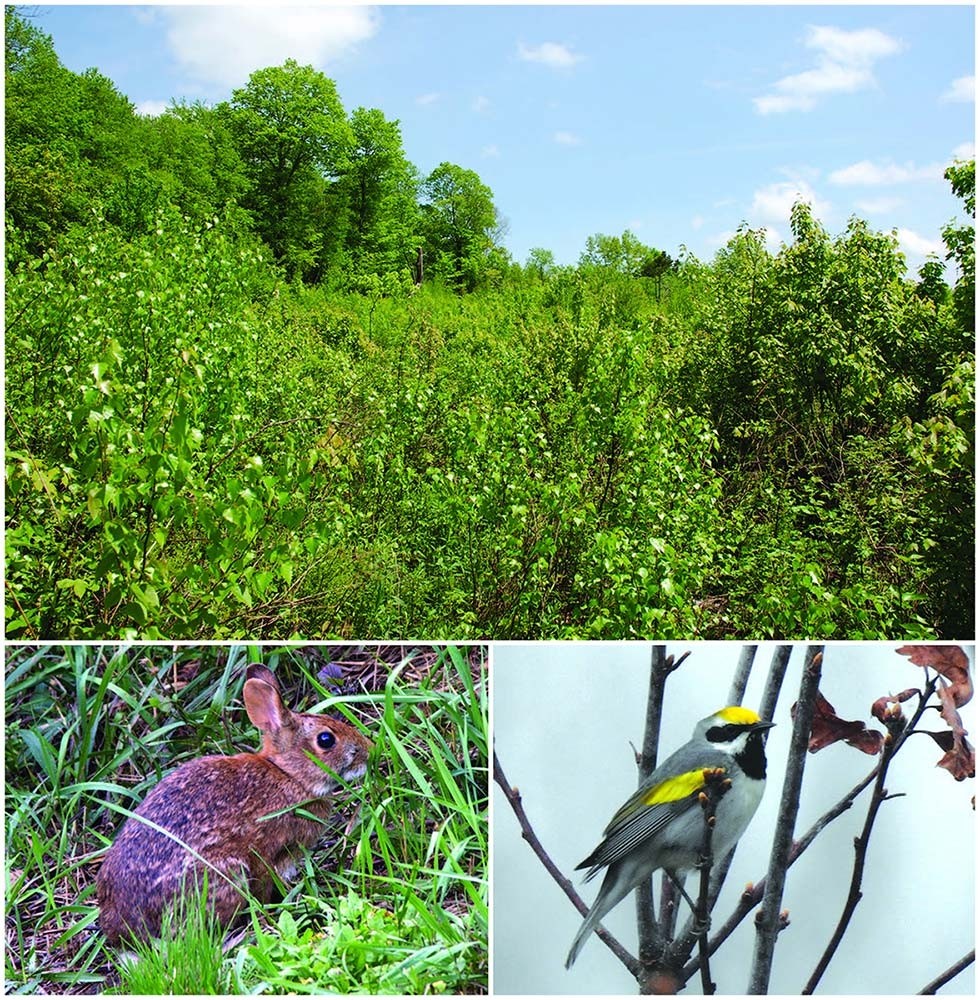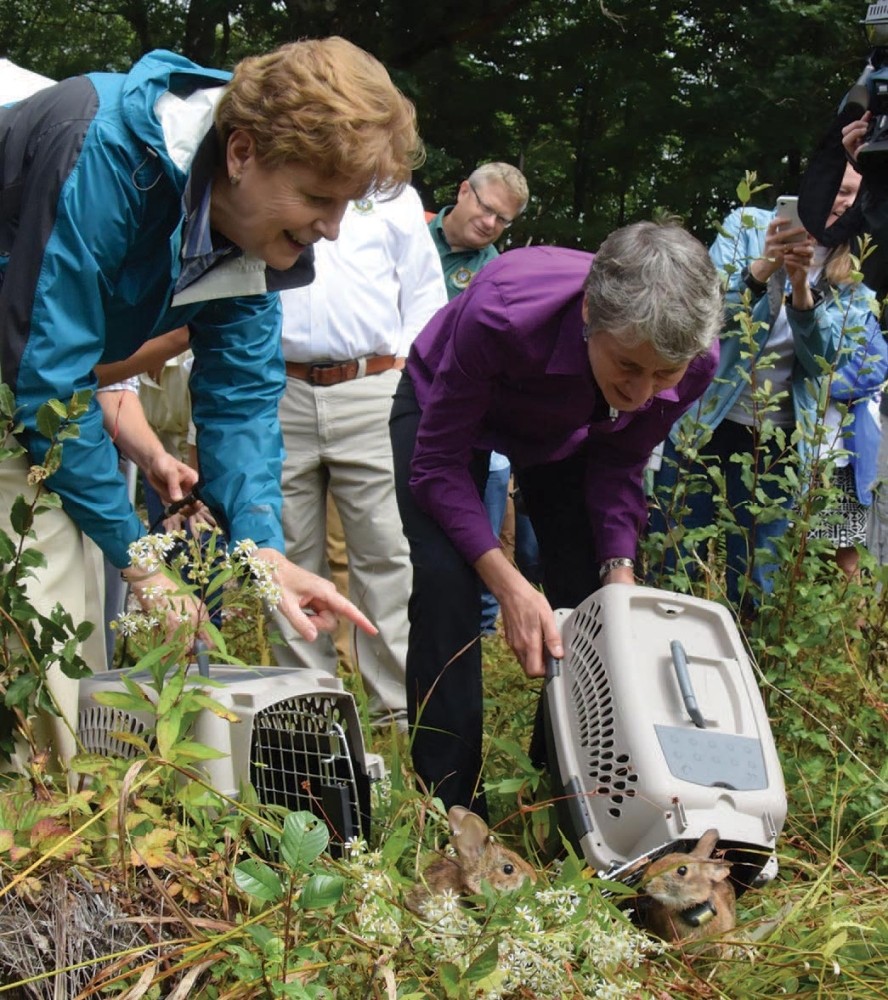How Private Lands Can Provide Critical Wildlife Habitats
Back in the 1980s, I began a long-term project with New England cottontails to explore the causes of their regional decline and how that situation could be reversed. I found that cottontails were tightly affiliated with dense, woody vegetation found in shrublands, regenerating forests, and some old fields (collectively called “thickets”). Such habitats have been in decline throughout the northeastern United States for quite some time, and the animals dependent on these habitats have likewise declined. So, restoring New England cottontails and other thicket-dependent species requires creating and maintaining suitable habitats. An obvious starting point for generating additional habitats is public lands that include state and national forests, wildlife refuges, and other conservation lands. But, with only 10 percent or less of the land base within the range of New England cottontails publicly owned and suitable for management, private lands need to be part of the solution.
Many landowners recognize they have a role in the stewardship of nature. Yet, gaining their support to benefit species such as New England cottontails can be challenging. Economics has an obvious influence on decisions made by landowners, and incentive programs can encourage participation in habitat conservation. These programs benefit a wide range of taxa, from popular game species to at-risk plants and animals. They include monetary grants, cost sharing, incentive payments, rental contracts, and conservation easement purchases. Grants or cost-share programs pay all or part of the costs associated with habitat restoration. For example, New Hampshire Fish and Game has a grant program that provides funds to private landowners to cover costs associated with a wide range of actions, including generating forest opening, releasing wild apple trees, and maintaining thicket habitats. Because funds for this program come from a fee associated with hunting license purchases, there is an expectation that the managed lands will be open to public activities that include hunting. Similar programs exist in other states.
At the national level, several agencies are involved with habitat conservation on private lands. The Natural Resources Conservation Service (NRCS) within the U.S. Department of Agriculture is the most prominent. NRCS was established more than 80 years ago as the Soil Conservation Service to address soil conservation needs in response to the Dust Bowl of the 1930s.
Today, NRCS works with private landowners to conserve soil, water, air, plants, and animals that contribute toward productive lands and healthy ecosystems. In 2012, NRCS and the U.S. Fish & Wildlife Service developed a partnership for private landowners to voluntarily participate in Working Lands for Wildlife (WLFW). That approach was initially targeted toward farm, ranch, and forest owners who had a capacity to benefit at-risk species through voluntary, incentive-based actions.
Responding to the Needs of At-Risk Species
Privately owned lands are especially important when addressing the needs of at-risk plants and animals because these lands support populations of more than two-thirds of the species listed under the Endangered Species Act, with 10 percent of all listed species occurring only on private lands. Additionally, many species that are in jeopardy of being listed also occur on private lands. In the northeastern United States, a suite of species that are dependent on thicket habitats are vulnerable as a result of habitat loss and fragmentation. In addition to New England cottontails, golden-winged warblers are among the species at greatest risk. For cottontails, thickets are essential, year-round habitat. For golden-winged warblers, thickets are critical nesting habitat. Expanding development and changes in land uses have substantially reduced the abundance and diversity of these habitats. Those habitats that remain are often small and isolated. As a result, New England cottontails currently occupy less than 15 percent of their historic range. Likewise, populations of golden-winged warblers have declined by almost 3 percent annually for the past 50 years, and they now have one of the smallest populations of any songbird not on the Endangered Species List.
To address these declines, conservation strategies established for both New England cottontails and golden-winged warblers are informing major efforts of WLFW in the Northeast. These strategies, developed with input from state and federal agencies, university researchers, and nongovernmental organizations, include specific goals for habitat and population restoration. To achieve these goals, conservation partners identified habitat focus areas for concentrating land management actions. Focus areas were based on the recent distribution of remaining populations of cottontails and warblers, plus characteristics of particular landscape types that are compatible with generating thicket habitats. In these areas, NRCS-funded efforts are directed toward recruiting private landowners and developing management plans to aid both species.
Gaining landowner support to benefit at-risk species can be challenging. Some may already carry skepticism toward government programs and are concerned that having at-risk species on their land may interfere with current or future activities. NRCS staff spend much of their time cultivating relationships with landowners. According to Don Keirstead, NRCS Resource Conservationist in New Hampshire, “Identifying a local resident who is familiar with key landowners and is willing to reach out to neighbors and initiate engagement can be quite successful.” Working in landscapes known to support New England cottontails, landowners and NRCS staff develop voluntary recommendations to secure core patches of habitat that are at least 12 acres, an area that promotes cottontail survival, and to improve connectivity with other cottontail habitats. Assuring landowners that involvement with a WLFW project will not adversely affect their current and future land management plans is an essential portion of the arrangement.
Once a landowner’s goals and objectives are clear, the discussion of funding comes next. NRCS provides financial assistance to landowners, typically 75 to 90 percent of costs that promote needed habitats. A similar process is followed to manage habitat for golden-winged warblers. On-the-ground actions include setting back forest succession with timber harvests, mowing, or controlled fires to promote the re-growth of dense shrubs and young trees. After such treatments, emerging thickets become suitable for cottontails or warblers.
If You Provide Habitat, Will They Come?
In the Northeast, about 40,000 acres of thicket habitat have been managed for New England cottontails and golden-winged warblers in the past 20 years – many with WLFW support. Several years ago, I visited a group of habitats managed for cottontails to get a sense of their suitability. Basing my evaluation on features essential for cottontails (especially understory vegetation), I found that nearly a third of sites needed more growing time to adequately gauge their progress, but more than 40 percent of the sites were rabbit ready or moving toward suitability. The remaining sites were unlikely to develop essential features, often because of poor soils. Although those habitats will not support a breeding population of cottontails, they may function as “steppingstone” habitats as cottontails disperse from other habitats. Assuring connectivity among established and developing populations is critical to long-term survival. Where newly managed habitats can be isolated from existing populations, captive breeding and “trap-and-transfer” efforts from stable populations are being used to establish cottontails in some of the newly created habitats.
Professor Jeffery Larkin at Indiana University of Pennsylvania and his students have been studying efforts to recover golden-winged warblers for decades. In addition to developing habitat management guidelines, Larkin has evaluated the responses by warblers to newly developed thicket habitats. In a recent survey of 450 managed habitats, Larkin found that 22 percent of them were indeed occupied by nesting warblers. According to Larkin “a 22 percent occupancy rate of new habitats is not an overwhelming success, but it is substantial given the current status of warblers.”
Perhaps more encouraging, Larkin also found a near doubling of golden-winged warbler occupancy on public lands since the initiation of WLFW efforts. That increase may be a consequence of existing populations expanding into nearby habitats because, similar to New England cottontails, warbler occupancy of new habitats was found to be dependent on proximity to other known populations.
There are numerous other challenges in determining if habitat restoration efforts are having a positive effect on cottontail and warbler populations. For both species, there are specific, essential habitat features. For example, New England cottontails may not move into a site until 10 years after management, when regrowth of vegetation is very dense and provides both food and cover from predators. Golden-winged warblers seem to prefer habitats eight years after management. As a result, it will take some time to determine if efforts are successful in increasing population sizes of both species. Additionally, threats such as disease, climate change, and cultural and economic drivers of land use can all interact to limit wildlife responses. These factors can muddle any evaluation of WLFW actions if the evaluation is based on a single-species response.
To overcome these limitations, Bridgett Costanzo (WLFW regional coordinator in the eastern United States) recommends taking a broader perspective of community and ecosystem responses when evaluating the outcomes of WLFW efforts. For instance, among a sample of sites managed for or occupied by New England cottontail, 11 thicket-affiliated species of birds were detected. This included prairie warblers, a species of regional conservation concern. Other birds dependent on herbaceous openings and low shrubs common to early-growth habitats (with vegetation not yet dense enough to suit cottontails) were documented, further showing an important value of management activities. The abundance and diversity of flowering plants within sites managed for cottontails and warblers also attracted substantial groups of native bees. These observations demonstrate meaningful benefits to other species helped by WLFW actions.
A Timely Response for Species in Jeopardy
New England cottontails, golden-winged warblers, and spotted turtles (see opposite page) are included among the species aided by WLFW projects that have been or are currently being considered for listing under the Endangered Species Act. The advantages of WLFW include responding to population declines before federal listing is necessary to avoid both extinction risks and adverse economic impacts. The decision process to federally list a species as threatened or endangered is quite lengthy, taking an average of 12 years from proposal to listing. For instance, New England cottontails were first listed as a candidate for endangered species status back in 1989. It was not until 2015 that the U.S. Fish & Wildlife Service decided not to list them, largely because of the recovery efforts that were initiated by collaborating agencies and WLFW several years earlier. Listing under the Endangered Species Act can also have economic effects that are detrimental to the public’s competing priorities and can create conflict with private landowners, dampening their willingness to participate in conservation actions. WLFW has the ability to respond to habitat and population declines before federal listing, and landowners are protected from any legal jeopardy during their enrollment in WLFW efforts.
The contributions of WLFW projects for developing and protecting habitats for at-risk species have been substantial. Since its emergence, WLFW projects have affected more than 10 million acres of wildlife habitat in 48 states. According to Costanzo, “WLFW is a win-win approach for producers (Working Lands) and target species (For Wildlife).” In recent years, WLFW has expanded to include other species with well-documented habitat and population declines but no endangered species implications – such as black ducks. There has also been a shift from single-target species to a greater emphasis on restoring at-risk ecosystems and the wildlife communities dependent on them. The relationship with private landowners continues to be a cornerstone of the program. Recognizing and appealing to landowner motivations are essential steps toward developing good relationships. Having a shared vision with private landowners should aid in ensuring the longevity of conservation actions within working landscapes.





